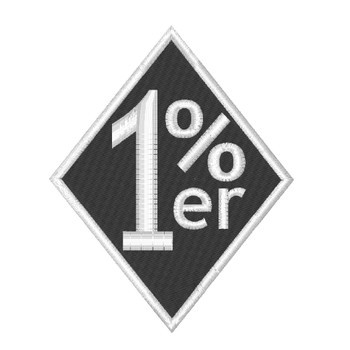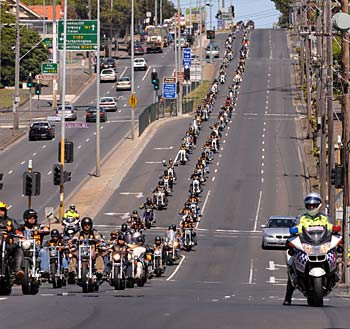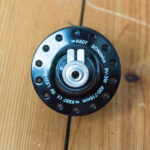The term “1% biker” or “one percenter” is a phrase deeply embedded in motorcycle culture, particularly when discussing outlaw motorcycle clubs. Groups like the Hells Angels, Bandidos, Pagans, and Outlaws are often labeled as “1% motorcycle clubs.” This designation sets them apart from the majority of motorcycle enthusiasts, suggesting that while 99% of riders are law-abiding citizens enjoying the open road, the “1 percenters” operate outside the norms of conventional society. But where did this term originate, and what does it truly mean to be a 1% biker?
 one percenter patchA close-up of a “1%” patch, a symbol worn by members of outlaw motorcycle clubs to signify their one-percenter status.
one percenter patchA close-up of a “1%” patch, a symbol worn by members of outlaw motorcycle clubs to signify their one-percenter status.
The Origin and History of the One Percenter Term
The expression “one percenter” wasn’t always associated with outlaw motorcycle clubs. Its roots trace back to the aftermath of the 1947 Hollister Riot in Hollister, California. Following this event, the American Motorcycle Association (AMA) reportedly made a public statement to distance themselves from the unruly behavior. The AMA asserted that 99% of motorcycle riders were law-abiding citizens, implying that only a small fraction were responsible for the chaos.
In response to this statement, and perhaps with a touch of defiance, some motorcycle clubs at the time embraced the “1%” label. They adopted it as a badge of honor, signifying that they were indeed the “other 1%” – the rebels, the non-conformists, the ones who lived life on their own terms, outside the perceived constraints of mainstream society. This marked the birth of the “1% biker” identity, a symbol of outlaw motorcycle culture.
The Rise of Outlaw Motorcycle Clubs and the 1% Biker
The emergence of outlaw motorcycle clubs and the solidification of the “1% biker” identity was heavily influenced by post-World War II America. The late 1940s saw a significant number of veterans returning home, many of whom struggled to reintegrate into civilian life. Accustomed to the camaraderie and adrenaline of wartime, some veterans found post-war normalcy lacking in excitement and brotherhood.
Simultaneously, there was a surplus of ex-military Harley Davidson motorcycles available after the war. These powerful machines, combined with the veterans’ desire for adventure and camaraderie, created a fertile ground for the growth of motorcycle clubs. For many ex-servicemen, motorcycles became a way to recapture the thrill and brotherhood they experienced during the war. Outlaw motorcycle clubs, in particular, offered a sense of belonging and a lifestyle that was deliberately outside the boundaries of conventional society, solidifying the image of the 1% biker as a rebel and an outsider.
 multiple one percenter clubs meetingA gathering of members from various one-percenter motorcycle clubs, showcasing the scale and organized nature of these groups.
multiple one percenter clubs meetingA gathering of members from various one-percenter motorcycle clubs, showcasing the scale and organized nature of these groups.
Prominent 1% Motorcycle Clubs Worldwide
One percent motorcycle clubs are not confined to a single region; they have a global presence. Clubs like the Hells Angels and Outlaws, for example, have expanded internationally, establishing local chapters in numerous cities and countries. These chapters, sometimes called “charters,” operate under the umbrella of the larger club, extending the reach and influence of the 1% biker culture.
While often portrayed as secretive and underground, many outlaw motorcycle clubs operate as legal entities. They often produce and sell merchandise, known as “supporter gear,” which allows those who are not members but are sympathetic to the club’s ideals to show their affiliation. Some of the most recognized 1% motorcycle clubs around the world include:
- Hells Angels Motorcycle Club
- Outlaws Motorcycle Club
- Bandidos Motorcycle Club
- Pagans Motorcycle Club
- Mongols Motorcycle Club (not mentioned in original, adding for comprehensiveness)
- Vagos Motorcycle Club (not mentioned in original, adding for comprehensiveness)
The 1% Patch: A Symbol of Outlaw Identity
A defining symbol of a 1% biker is the “1%” patch itself. Members of clubs who identify as one percenters proudly display this patch, or variations like “1%er,” on their motorcycle vests or jackets. This patch serves as an immediate visual declaration of their allegiance to the outlaw biker lifestyle and their separation from mainstream motorcycle culture. It’s a symbol of rebellion, brotherhood, and commitment to a life outside the perceived rules of the 99%.
Media Portrayal and the Reality of 1% Bikers
One percent motorcycle clubs are frequently featured in media reports, often in the context of criminal activities. News stories tend to highlight instances of violence or illegal actions involving club members, contributing to a public perception of 1% bikers as inherently criminal. While it’s undeniable that some individuals within these clubs have engaged in criminal behavior, media coverage can sometimes be disproportionate, potentially exaggerating the extent of criminal involvement across all 1% clubs and members.
It’s important to acknowledge that the majority of violent crime associated with outlaw motorcycle clubs often occurs between rival clubs rather than targeting the general public. For ordinary citizens, the common wisdom, “stay out of their way, and they will stay out of yours,” often holds true. However, the media focus on crime tends to overshadow the complex realities of 1% biker culture.
 one percenter bikers and policeA group of one-percenter bikers during a police stop, illustrating the frequent interactions between law enforcement and these clubs.
one percenter bikers and policeA group of one-percenter bikers during a police stop, illustrating the frequent interactions between law enforcement and these clubs.
Government Scrutiny and the Legal Landscape for 1% Bikers
In recognition of the organized nature and, at times, criminal activities associated with some outlaw motorcycle clubs, government agencies have taken measures to address potential illegal operations. In the United States, for example, major 1% motorcycle clubs like the Hells Angels, Bandidos, Outlaws, and Pagans have been targeted under the RICO Act (Racketeer Influenced and Corrupt Organizations Act). This legislation, originally designed to combat the Mafia, allows for the prosecution of organized criminal enterprises, including certain motorcycle clubs.
Globally, governments outside the US have also implemented strategies to counter outlaw motorcycle gangs. These measures can include laws aimed at restricting the activities of club members and disrupting their organizational structures. The legal landscape surrounding 1% bikers is constantly evolving as law enforcement agencies adapt to the challenges posed by these groups.
Understanding the 1% Biker
So, when someone asks, “What is a 1% biker?”, you can now provide a comprehensive answer. It’s a term that originated from a defiant response to public perception, evolving into a symbol of outlaw motorcycle culture. It represents a lifestyle choice, a sense of brotherhood, and for some, a deliberate rejection of mainstream societal norms. While media portrayals often focus on the criminal aspect, the reality of 1% biker culture is multifaceted and deeply rooted in motorcycle history and post-war social dynamics. Understanding the term requires looking beyond the headlines and delving into the history, motivations, and complexities of the 1% biker world.

